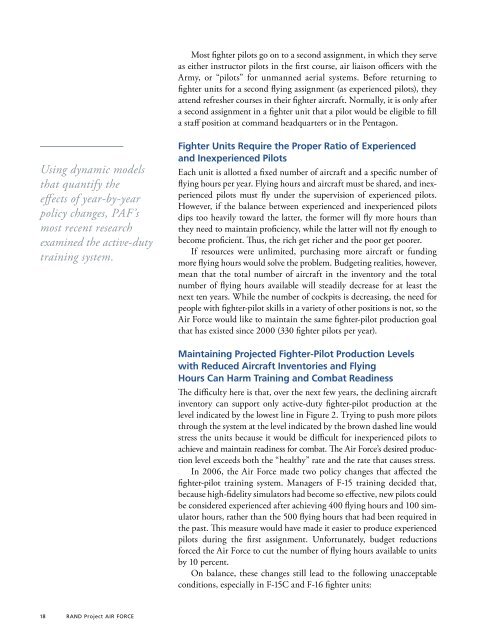RAND Project AIR FORCE Annual Report 2007 - RAND Corporation
RAND Project AIR FORCE Annual Report 2007 - RAND Corporation
RAND Project AIR FORCE Annual Report 2007 - RAND Corporation
You also want an ePaper? Increase the reach of your titles
YUMPU automatically turns print PDFs into web optimized ePapers that Google loves.
Most fighter pilots go on to a second assignment, in which they serveas either instructor pilots in the first course, air liaison officers with theArmy, or “pilots” for unmanned aerial systems. Before returning tofighter units for a second flying assignment (as experienced pilots), theyattend refresher courses in their fighter aircraft. Normally, it is only aftera second assignment in a fighter unit that a pilot would be eligible to filla staff position at command headquarters or in the Pentagon.Using dynamic modelsthat quantify theeffects of year-by-yearpolicy changes, PAF’smost recent researchexamined the active-dutytraining system.Fighter Units Require the Proper Ratio of Experiencedand Inexperienced PilotsEach unit is allotted a fixed number of aircraft and a specific number offlying hours per year. Flying hours and aircraft must be shared, and inexperiencedpilots must fly under the supervision of experienced pilots.However, if the balance between experienced and inexperienced pilotsdips too heavily toward the latter, the former will fly more hours thanthey need to maintain proficiency, while the latter will not fly enough tobecome proficient. Thus, the rich get richer and the poor get poorer.If resources were unlimited, purchasing more aircraft or fundingmore flying hours would solve the problem. Budgeting realities, however,mean that the total number of aircraft in the inventory and the totalnumber of flying hours available will steadily decrease for at least thenext ten years. While the number of cockpits is decreasing, the need forpeople with fighter-pilot skills in a variety of other positions is not, so theAir Force would like to maintain the same fighter-pilot production goalthat has existed since 2000 (330 fighter pilots per year).Maintaining <strong>Project</strong>ed Fighter-Pilot Production Levelswith Reduced Aircraft Inventories and FlyingHours Can Harm Training and Combat ReadinessThe difficulty here is that, over the next few years, the declining aircraftinventory can support only active-duty fighter-pilot production at thelevel indicated by the lowest line in Figure 2. Trying to push more pilotsthrough the system at the level indicated by the brown dashed line wouldstress the units because it would be difficult for inexperienced pilots toachieve and maintain readiness for combat. The Air Force’s desired productionlevel exceeds both the “healthy” rate and the rate that causes stress.In 2006, the Air Force made two policy changes that affected thefighter-pilot training system. Managers of F-15 training decided that,because high-fidelity simulators had become so effective, new pilots couldbe considered experienced after achieving 400 flying hours and 100 simulatorhours, rather than the 500 flying hours that had been required inthe past. This measure would have made it easier to produce experiencedpilots during the first assignment. Unfortunately, budget reductionsforced the Air Force to cut the number of flying hours available to unitsby 10 percent.On balance, these changes still lead to the following unacceptableconditions, especially in F-15C and F-16 fighter units:18 <strong>RAND</strong> <strong>Project</strong> <strong>AIR</strong> <strong>FORCE</strong>
















